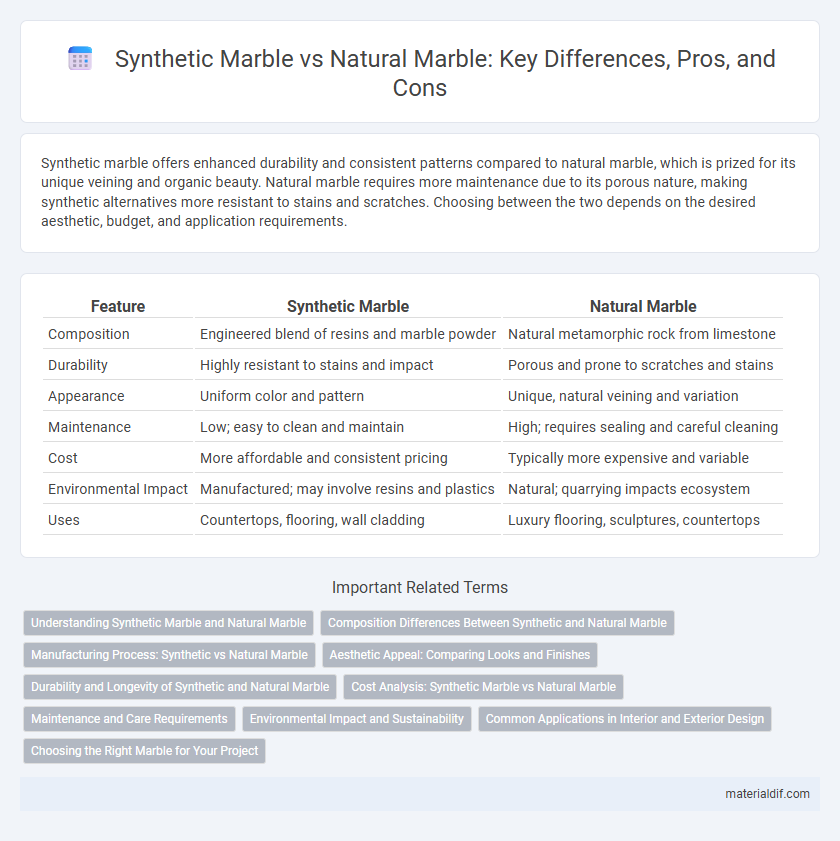Synthetic marble offers enhanced durability and consistent patterns compared to natural marble, which is prized for its unique veining and organic beauty. Natural marble requires more maintenance due to its porous nature, making synthetic alternatives more resistant to stains and scratches. Choosing between the two depends on the desired aesthetic, budget, and application requirements.
Table of Comparison
| Feature | Synthetic Marble | Natural Marble |
|---|---|---|
| Composition | Engineered blend of resins and marble powder | Natural metamorphic rock from limestone |
| Durability | Highly resistant to stains and impact | Porous and prone to scratches and stains |
| Appearance | Uniform color and pattern | Unique, natural veining and variation |
| Maintenance | Low; easy to clean and maintain | High; requires sealing and careful cleaning |
| Cost | More affordable and consistent pricing | Typically more expensive and variable |
| Environmental Impact | Manufactured; may involve resins and plastics | Natural; quarrying impacts ecosystem |
| Uses | Countertops, flooring, wall cladding | Luxury flooring, sculptures, countertops |
Understanding Synthetic Marble and Natural Marble
Synthetic marble, composed of crushed natural stone mixed with resins and pigments, offers enhanced durability and uniform appearance compared to natural marble. Natural marble consists of metamorphosed limestone with unique veining patterns and a porous surface that requires regular sealing for maintenance. Both types provide aesthetic appeal, but synthetic marble allows for greater customization and resistance to staining and scratching.
Composition Differences Between Synthetic and Natural Marble
Synthetic marble is composed primarily of crushed natural marble or stone powders bound with resins and polymers, creating a homogenous and customizable material. Natural marble consists mainly of calcite or dolomite minerals formed through metamorphic processes, exhibiting unique veining and variations in texture and color. The key composition difference lies in synthetic marble's engineered blend of natural stone particles and binding agents, contrasting with the naturally occurring, crystalline mineral structure of natural marble.
Manufacturing Process: Synthetic vs Natural Marble
Synthetic marble is produced through a controlled manufacturing process that combines resins, pigments, and crushed natural stone, allowing for consistent color and pattern customization. In contrast, natural marble forms over millions of years through the metamorphism of limestone, resulting in unique veining and natural imperfections. The synthetic process allows for uniformity and enhanced durability, while natural marble reflects geological history and individual stone characteristics.
Aesthetic Appeal: Comparing Looks and Finishes
Synthetic marble offers consistent color patterns and a uniform finish that can be tailored to mimic various natural stone styles, providing a sleek and modern aesthetic. Natural marble showcases unique veining and color variations that create an authentic, timeless beauty prized in luxury interiors and architectural designs. The polished surface of synthetic marble maintains its shine without frequent sealing, whereas natural marble develops a patina over time that enhances its classic, elegant appeal.
Durability and Longevity of Synthetic and Natural Marble
Synthetic marble exhibits superior durability due to its engineered composition, making it highly resistant to scratches, stains, and impact compared to natural marble. Natural marble, while prized for its unique veining and classic beauty, is more porous and prone to etching, chipping, and wear over time, especially in high-traffic or moisture-prone areas. The longevity of synthetic marble typically exceeds natural marble in environments requiring robust surface resilience and minimal maintenance.
Cost Analysis: Synthetic Marble vs Natural Marble
Synthetic marble typically costs 20-30% less than natural marble due to lower extraction and processing expenses. Natural marble prices vary widely depending on rarity and quality but generally incur higher installation and maintenance costs. When evaluating total expenses, synthetic marble offers a more budget-friendly option without compromising aesthetic appeal.
Maintenance and Care Requirements
Synthetic marble requires less maintenance than natural marble due to its non-porous surface, which resists staining and does not need regular sealing. Natural marble demands frequent sealing and careful cleaning with pH-neutral products to prevent etching and staining. Both materials benefit from prompt spill cleanup, but synthetic marble's durability reduces long-term upkeep costs significantly.
Environmental Impact and Sustainability
Synthetic marble production typically uses resin and crushed stone, which can reduce quarrying and habitat destruction compared to natural marble extraction. Natural marble mining generates significant waste and carbon emissions due to heavy machinery and transport, impacting local ecosystems and increasing environmental degradation. While synthetic marble offers improved sustainability through controlled manufacturing and lower resource depletion, its resin components may pose challenges for biodegradability and recycling efforts.
Common Applications in Interior and Exterior Design
Synthetic marble is often used in bathroom countertops, wall panels, and flooring due to its durability and resistance to stains, making it ideal for high-moisture environments. Natural marble is preferred in luxury kitchens, fireplaces, and exterior facades for its unique veining and natural aesthetic, providing timeless elegance. Both materials are popular in interior and exterior design, but synthetic marble offers more versatility in color and pattern customization, while natural marble delivers authentic texture and heritage appeal.
Choosing the Right Marble for Your Project
Synthetic marble offers enhanced durability, lower maintenance, and consistent color patterns, making it ideal for high-traffic areas or commercial projects. Natural marble delivers unique veining and authentic elegance, preferred for luxury homes and classic designs requiring natural stone's timeless appeal. Selecting the right marble depends on balancing budget, aesthetic preferences, and project-specific durability needs to ensure optimal performance and appearance.
Synthetic Marble vs Natural Marble Infographic

 materialdif.com
materialdif.com